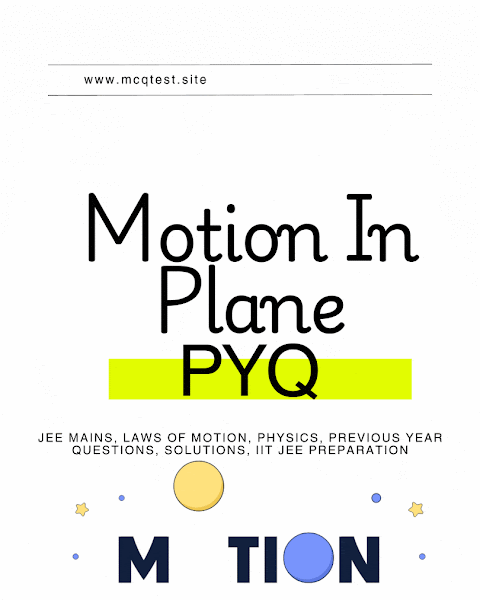MCQs on Motion In Plane for JEE Mains
Q1: At the top of the trajectory of a projectile, the directions of its velocity and acceleration are:
Correct Answer: A) Perpendicular to each other
Explanation: At the top of a projectile's path the velocity is entirely horizontal while the acceleration due to gravity is vertical downward, making them perpendicular.
Q2: A man projects a coin upwards from the gate of a uniformly moving train. The path of the coin for the man will be:
Correct Answer: C) Vertical straight line
Explanation: Since the coin is thrown upward from the moving train and retains the train’s horizontal velocity, for the man onboard it appears to move vertically up and down.
Q3: A stone is projected at an angle to the horizontal. A small piece separates from the stone before it reaches its maximum height. Then this piece will:
Correct Answer: C) Fly horizontally initially and will trace a different parabolic path
Explanation: When the small piece detaches before the stone reaches maximum height, it retains the instantaneous horizontal component of the velocity. Without any extra vertical component from the separation, it initially moves horizontally and then follows its own parabolic path under gravity.
Q4: A particle moves in the \(xy\)-plane according to \( x = kt \) and \( y = kt(1 - \alpha t) \), where \( k \) and \( \alpha \) are positive constants. What is the equation of its trajectory?
Correct Answer: A) \( y = x - \frac{\alpha}{k}x^2 \)
Explanation: From \( x = kt \), we have \( t = \frac{x}{k} \). Substituting into \( y = kt(1 - \alpha t) \) gives \( y = x\left(1 - \frac{\alpha}{k}x\right) \) or \( y = x - \frac{\alpha}{k}x^2 \), which is a parabolic trajectory.
Q5: An object is projected with 20 m/s at an angle of 45° with the horizontal. Its trajectory is given by \( h = Ax - Bx^2 \) (where \( h \) is height and \( x \) is horizontal distance). With \( g = 10 \) m/s², what is the ratio \( A:B \)?
Correct Answer: D) 40 : 1
Explanation: The standard trajectory equation is \( y = x\tan\theta - \frac{g}{2u_x^2}x^2 \). For \(\theta = 45°\), \(\tan45° = 1\) and \(u_x = 20\cos45° = 10\sqrt{2}\) m/s. Hence, \( A = 1 \) and \( B = \frac{10}{2(200)} = \frac{1}{40} \) so that \( A:B = 1:\frac{1}{40} \) which is equivalent to 40:1.
Q6: A ball is dropped from the top of a tower in a high-speed wind. The wind exerts a steady force on the ball. The path followed by the ball will be:
Correct Answer: A) Parabola
Explanation: The constant horizontal force due to wind adds a uniform horizontal acceleration, while gravity acts vertically. The combination produces a parabolic path.
Q7: In projectile motion, the velocity is:
Correct Answer: C) Perpendicular to the acceleration for one instant only
Explanation: The only instant when the projectile’s velocity is perpendicular to gravity (the only acceleration acting) is at the peak of its trajectory when the velocity is horizontal.
Q8: From the top of a 19.6 m high tower, a ball is thrown horizontally. If the line joining the point of projection to the impact point makes an angle of 45° with the horizontal, then the initial velocity of the ball is:
Correct Answer: A) 9.8 m/s
Explanation: The time to fall from 19.6 m is \( t = \sqrt{\frac{2h}{g}} = \sqrt{\frac{39.2}{9.8}} = 2 \) s. For the displacement line to make a 45° angle, \( \tan45° = \frac{19.6}{2u} = 1 \) which gives \( u = 9.8 \) m/s.
Q9: A body is thrown horizontally from the top of a 5 m high tower and lands 10 m from its base (with \( g = 10 \) m/s²). The initial velocity is:
Correct Answer: C) 10 m/s
Explanation: The fall time is \( t = \sqrt{\frac{2h}{g}} = \sqrt{\frac{10}{10}} = 1 \) s. The horizontal distance of 10 m implies an initial horizontal speed of \( \frac{10}{1} = 10 \) m/s.
Q10: An aeroplane is moving with a horizontal velocity \( u \) at a height \( h \) above the ground. If a packet is dropped from it, the speed of the packet when it reaches the ground will be:
Correct Answer: B) \( \sqrt{u^2 + 2gh} \)
Explanation: Upon release, the packet has an initial horizontal speed \( u \) and gains a vertical speed \( \sqrt{2gh} \) while falling. Its resultant speed is \( \sqrt{u^2 + ( \sqrt{2gh} )^2} = \sqrt{u^2 + 2gh} \).





.png)

0 Comments